Whereas pruning a neighbor’s a lot uncared for Hydrangea paniculata just lately, I discovered myself musing on the historical past of this genus in American gardening, whose recognition has waxed and waned via the years. Grown all through the nation in its many kinds and employed in numerous methods, Hydrangea has discovered prominence in each model of backyard. Usually, hydrangeas have been taken as a right and left unattended, like this one I used to be pruning. But even amongst such disregard, this versatile decorative lives on, successful over new generations of followers.
Hydrangea Rising Fundamentals
(hı¯-dran-juh)
• Genus of principally deciduous shrubs, small bushes, and climbers.
• Many cultivars are hardy to USDA Hardiness Zone 4 (–30°F).
• Most choose safety from harsh, noon solar.
• Want moist, humus-rich soil, however are adaptable to many situations.
• Usually pest and illness resistant.
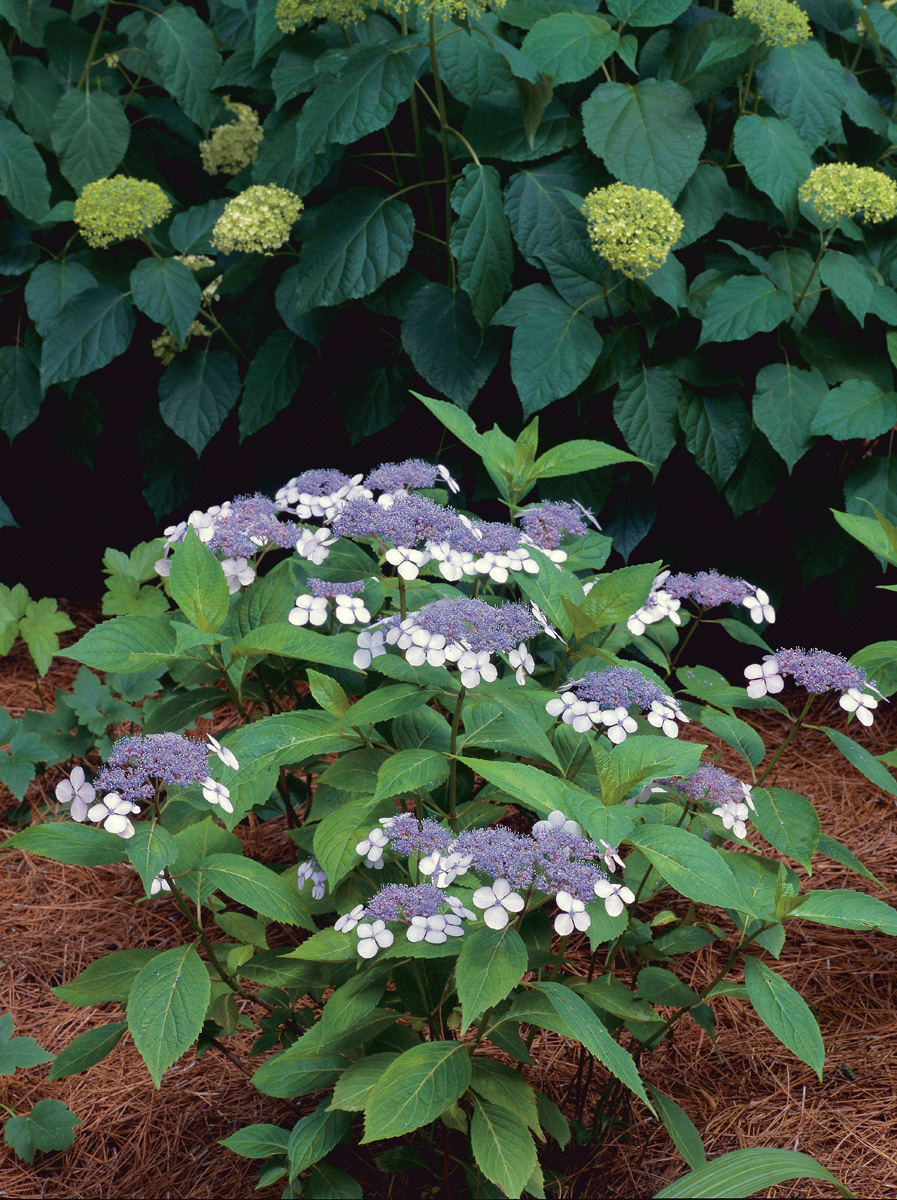
Greater than 50 cultivated types of Hydrangea are derived from 5 well-liked species: H. paniculata, H. macrophylla, H. quercifolia, H. arborescens, and H. anomala ssp. petiolaris. They vary in peak from 18 inches to 30 toes, and in kind from a climbing vine, to a dense, bushy shrub, to a weeping tree.
The title Hydrangea is from the Greek “hydor” (water) and “aggeion” (vessel), referring to their cup-shaped seed capsules. Hydrangeas are among the many best ornamentals to develop, thriving in a wide range of climates and situations. They need a humus-rich soil, ample moisture, and aid from noon solar. Add an annual pruning particular to the species, and also you’ve taken care of their wants. All are simply propagated from cuttings.
Prune H. paniculata for big, snowy flowers
H. paniculata, native to China and Japan, and thriving to USDA Hardiness Zone 3 (–40°F), is the enormous of the genus. A mature specimen, properly saved and in the suitable place, is a sight to behold. With gracefully arching branches and pyramidal, opulent clusters of snowy-white, then pink-tinged to dusty-purple, and eventually, warm-wheat flower heads, it deserves a standing ovation in my corridor of excessive performers—particularly contemplating that few woody shrubs bloom throughout this one’s showy season of July to September. With an upright behavior—changing into attractively vase-shaped and arching with age—it can attain 25 toes, with a variety of about 15 toes. Most frequently, it’s grown as a big shrub or small tree, saved to about 12 toes.
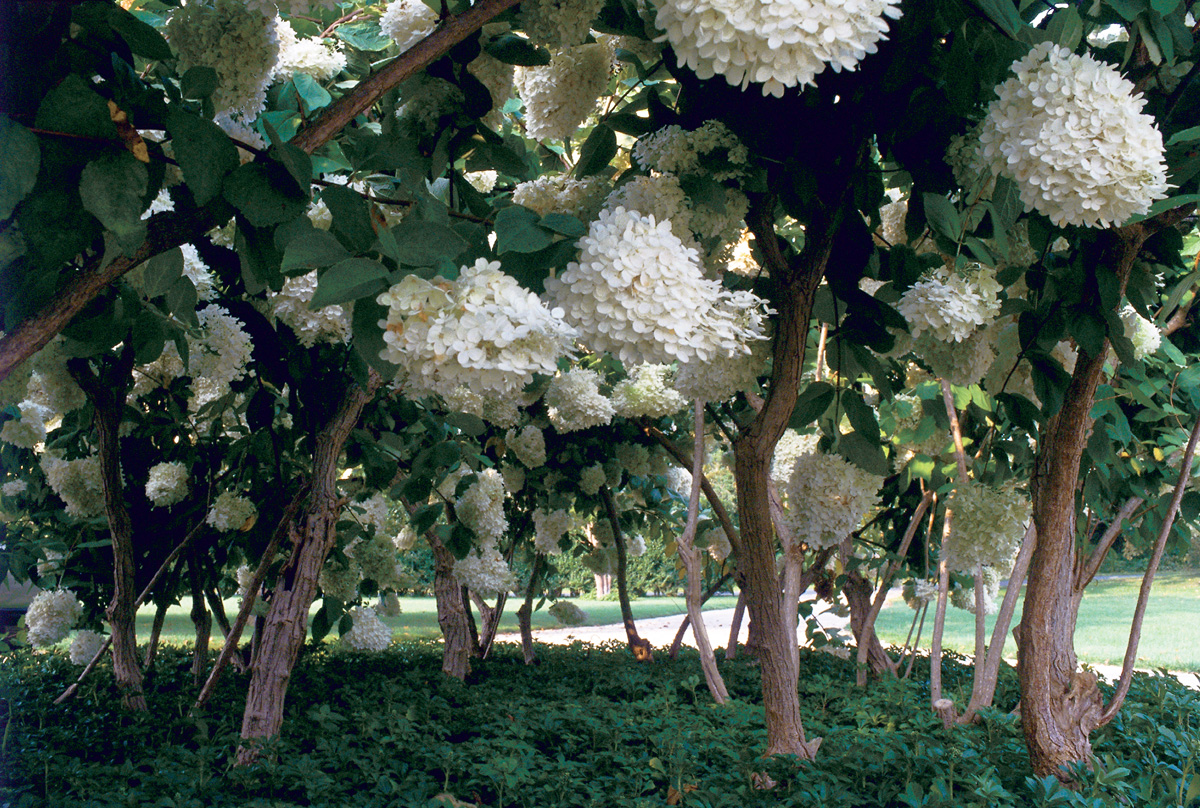
Due to its vigor, annual pruning is suggested. For a dense, bushy shrub, “head again” from the rising suggestions—reducing again by a number of leaf nodes—in early spring, shaping the plant whereas pruning out outdated and lifeless wooden. To acquire a small tree, prune out decrease and weaker branches from their level of origin, leaving three to 5 important branches close to to the bottom. From these, a dense, enticing crown will develop. Skinny yearly in late fall or early spring to take care of kind, and in the reduction of when the specified peak is achieved.
In case your H. paniculata has grown out of hand, a extreme spring pruning is so as. For greatest outcomes, fertilize first and wait per week or two. Then get out the loppers, tree noticed, and hand pruners, and reduce the plant again to the scale and kind you need.
If it’s bigger flower clusters you want, cut back the variety of rising shoots. By channeling its power to only a few shoots, H. paniculata will produce blossoms as much as 16 inches in size. These large blossoms will remind you why you selected this pretty decorative on your backyard.
Mophead hydrangea blossom colour is decided by soil pH
Maybe probably the most prized member of the household, H. macrophylla has lengthy been admired for its voluptuous, pink-to-red or blue-to-purple flower clusters. It is without doubt one of the first vegetation to have made the migration from Europe, the place it has been in cultivation for hundreds of years and was, earlier than that, a preferred plant in China and Japan.
H. macrophylla has a rounded behavior, rising to about 5 toes with daring, serrated, inexperienced leaves as much as 8 inches in size, which in some varieties are creamy-margined. The 6- to 10-inch flower clusters that seem in midsummer encompass each sterile (showy) and fertile (inconspicuous) blossoms.
There are two distinct flower varieties of H. macrophylla, the most effective identified being these with globe-shaped heads of primarily sterile flowers. These are the unique Hortensia, or mopheads, of our grandmothers’ gardens. The opposite is the disc-shaped lacecap selection, having an internal cluster of fertile flowers surrounded by conspicuous, sterile blossoms (photograph, dealing with web page). Every sort is beautiful; an try to decide on between them is futile—which is why I’ve each rising in my Brooklyn brownstone backyard.
H. macrophylla is the litmus-test plant of the backyard. Blue-to-purple blossoms show an acid soil. Add lime and so they develop into a mushy, fairly pink or hanging purple. If yours are pink and it’s blue you need, add aluminum sulfate or acidifying natural matter, equivalent to oak-leaf mould or peat moss. Or strive tossing a penny beneath your shrub; to this, my neighbor attributes her luscious, purple blooms.
Although undemanding and hardy to Zone 6 (–10°F), big-leaf hydrangeas do profit from a bit of annual care. In spring, lifeless wooden ought to be in the reduction of to reside wooden, and older branches—these over 3⁄4 inch in diameter—ought to be eliminated. This may encourage new development and enhance flower high quality.
Basic pruning to include dimension ought to be finished quickly after flowering, as lacecaps and mopheads bloom on the earlier 12 months’s wooden. In chilly climates, the place heavy freezing is probably going, a bit of winter safety is suggested. Hilling up of leaves or fir branches across the plant will diminish dieback and assist guarantee one other season of bloom.
Oakleaf hydrangeas are the least demanding
The recognition of oakleaf hydrangea (H. quercifolia) has elevated dramatically in recent times. Although this species brightens the backyard with erect, showy clusters of white blossoms in mid-July, it’s most appreciated for its 6-foot unfold of deep-green foliage. Left unpruned, the sprawling branches bear a lush abundance of oaklike leaves. When selectively thinned, it makes a particular specimen or container plant. Thinning is greatest finished in spring or simply after blooming.
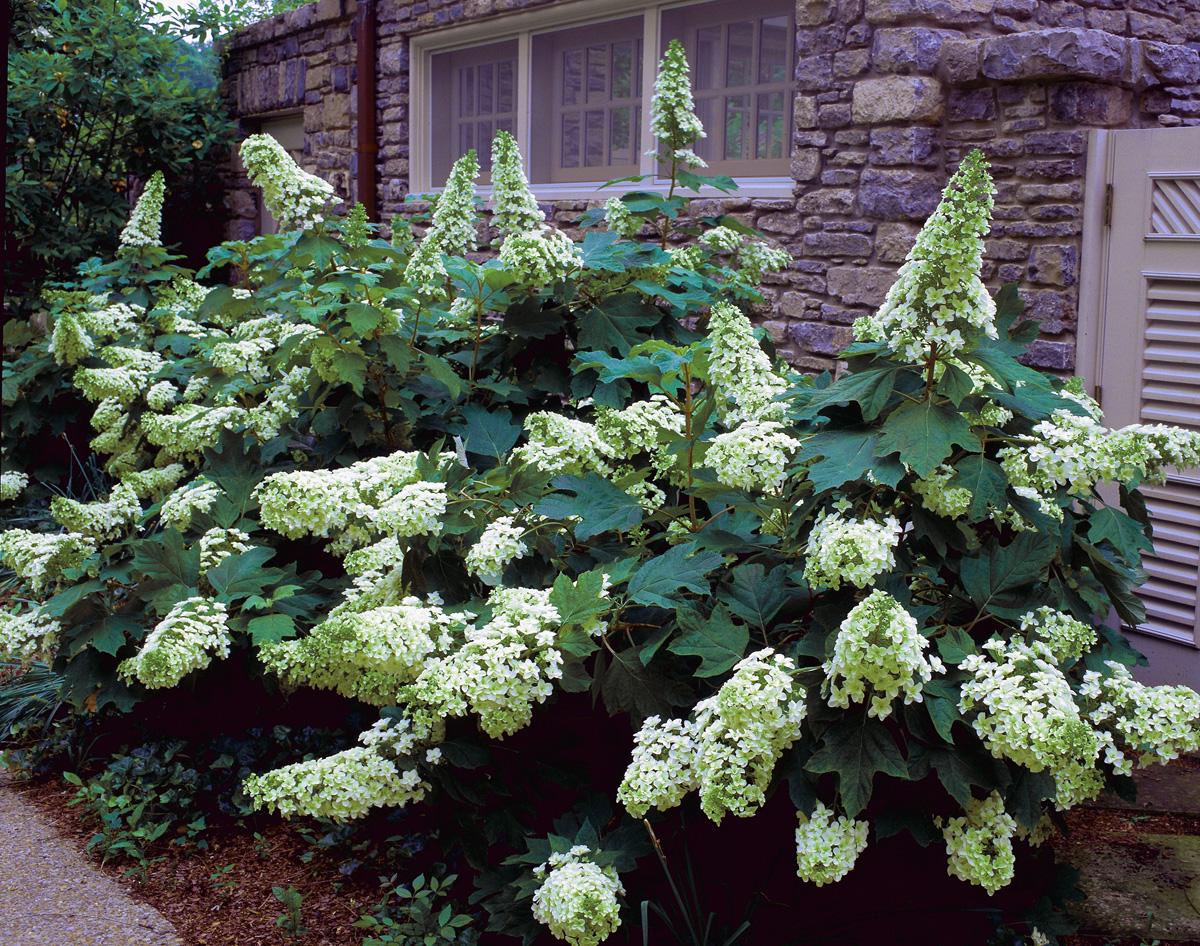
Oakleaf hydrangeas are the least demanding of this easy-care genus—taking each drier soils and extra open publicity than different species—and can develop in deep shade. Native to the southeastern U.S., oakleaf hydrangeas are hardy to Zone 5 (–20°F), the place they might die again to the bottom in winter. Since they flower on the earlier 12 months’s wooden, this precludes all bloom, however the wealthy inexperienced spring and summer time foliage, mahogany fall foliage, and good-looking, exfoliating winter bark is recompense sufficient for a plant that asks for thus little.
Skinny out outdated wooden of easy hydrangea
In opposition to the protests of many admirers, I take into account easy hydrangea (H. arborescens) to be the poor cousin of a distinguished household. In any case, it calls for greater than 6 toes of backyard area in all instructions, throwing out an overabundance of floppy, heart-shaped leaves. It most intently resembles the mopheads, but the flowers are half the scale and are available solely in white. Native to woods and stream banks from New York to Florida, and west to Missouri, some summer time shade or further moisture is a should.
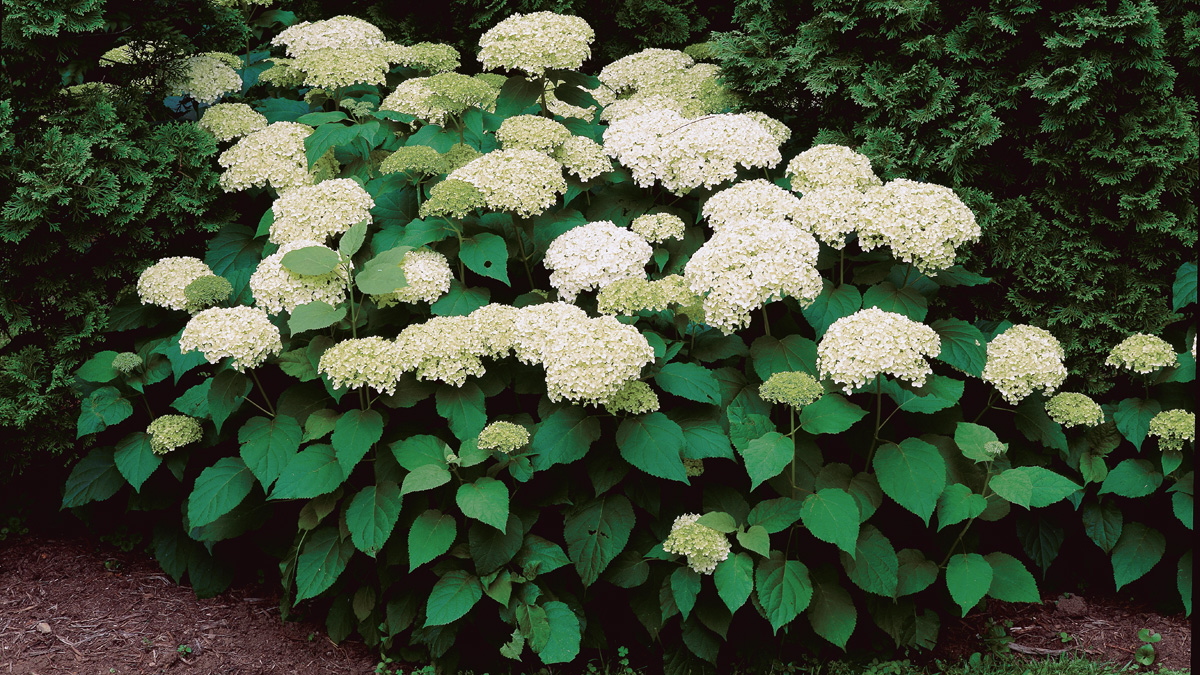
True, it blooms from June until frost, when few woody shrubs are showy, including a splash of coolness to these sizzling summer time days. True too, it’s among the many hardiest of the hydrangeas, and probably the most dependable to flower. It could freeze to the bottom in Zone 3, but will rebound in spring and bloom abundantly, as flowers bud from new development. Additionally it is the one hydrangea simply propagated by division; ought to it get too huge for its allotted plot, a portion can at all times be planted elsewhere. And, to present the plant its due, scaling down of outdated wooden in early spring will produce a extra enticing kind and bigger blossoms. Not unhealthy, actually, for a poor cousin.
Be affected person with younger climbing hydrangeas
H. anomala ssp. petiolaris—previously often called H. petiolaris—is the one vine of the genus Hydrangea. Although a sluggish starter till its roots are firmly established—often two to 3 years after planting—climbing hydrangea is an outstanding woody vine. It’s unsurpassed in vigor and class, rising 60 toes by the use of self-clinging, aerial “roots,” bearing an abundance of heart-shaped leaves. The white flower is a flat, lacy cluster of each fertile and sterile blossoms born on stiff, erect stems in mid-June and into July.
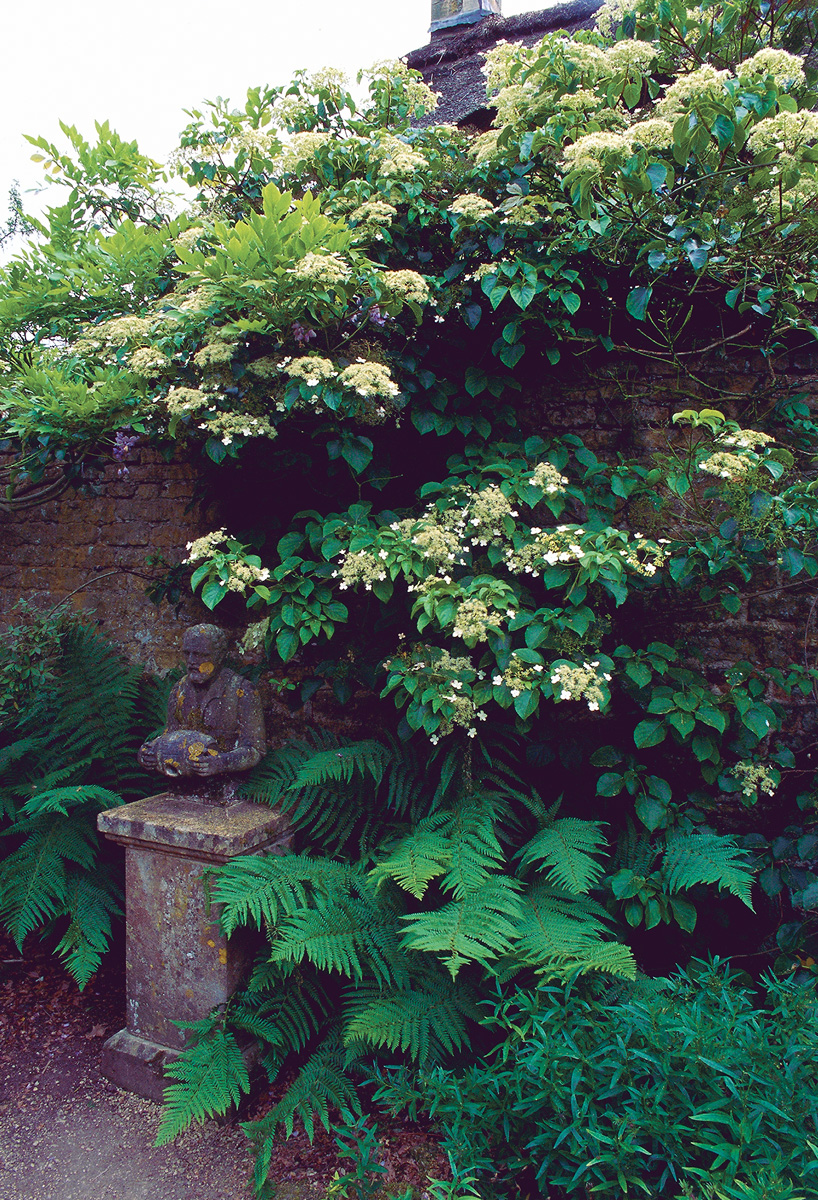
Endurance is the most effective ingredient to produce for the primary 12 months or so within the care of this East Asian native, which is hardy to Zone 4. Afterward, all you want are hand pruners. As soon as established, climbing hydrangea will shortly fill its allotted area and proceed climbing on something it will possibly sink its holdfasts into. It does very properly on partitions, and may climb bushes, fences, or some other construction with out the help of wires or lattice. Basic pruning is greatest finished instantly after blossoms fade, however touch-up work will be finished anytime. With just a bit care, long-lived hydrangeas will improve your backyard and enthrall generations of gardeners to return. m
With pruning shears in hand, horticulturist Keith Davitt cares for hydrangeas and enjoys gardening in Brooklyn, NY.
Sources for hydrangeas
These mail-order nurseries provide all 5 species of hydrangeas, plus many cultivars.
Carroll gardens, 444 East Principal St., Westminster, MD 21157; 800-638-6334.
Greer gardens, 1280 Goodpasture Island Rd., Eugene, OR 97401-1794; 541-686-8266.
Hydrangeas plus, 6543 S. Zimmerman Rd., Aurora, OR 97002; 503-651-2887.
Owen farms, 2951 Curve-Nankipoo Rd., Ripley, TN 38063-6653; 901-635-1588.
Wilkerson mill gardens, 9595 Wilkerson Mill Rd., Palmetto, GA 30268; 770-463-2400.